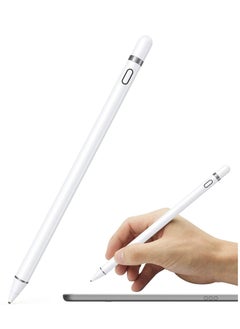Highlights- Touchscreen Compatibility: Stylus pens are designed to work with touchscreen devices, such as smartphones, tablets, 2-in-1 laptops, and graphic tablets.
- Pressure Sensitivity: Many digital pens come with pressure sensitivity, allowing users to vary the line thickness or opacity based on the pressure applied, providing a more natural and versatile drawing or writing experience.
- Precision and Accuracy: A high level of precision and accuracy is crucial, especially for tasks that require fine details, such as graphic design, digital art, or precise note-taking.
- Compatibility with Specific Devices: Some stylus pens are designed for specific devices or brands, such as Apple Pencil for iPads or Samsung S Pen for Samsung Galaxy devices.
- Button Controls: Some digital pens come with buttons that can be customized for various functions, such as erasing, right-clicking, or other shortcuts, enhancing the overall user experience.
OverviewTouchscreen Compatibility:
Stylus pens are designed to work with touchscreen devices, such as smartphones, tablets, 2-in-1 laptops, and graphic tablets.
Pressure Sensitivity:
Many digital pens come with pressure sensitivity, allowing users to vary the line thickness or opacity based on the pressure applied, providing a more natural and versatile drawing or writing experience.
Precision and Accuracy:
A high level of precision and accuracy is crucial, especially for tasks that require fine details, such as graphic design, digital art, or precise note-taking.
Compatibility with Specific Devices:
Some stylus pens are designed for specific devices or brands, such as Apple Pencil for iPads or Samsung S Pen for Samsung Galaxy devices.
Button Controls:
Some digital pens come with buttons that can be customized for various functions, such as erasing, right-clicking, or other shortcuts, enhancing the overall user experience.
Tilt Recognition:
Advanced digital pens may feature tilt recognition, allowing users to shade or draw at different angles, simulating a more natural pencil or brush experience.
Battery Life and Charging:
Depending on the type, digital pens may be rechargeable or use replaceable batteries. Consider the battery life and the charging mechanism when choosing a stylus.
Palm Rejection Technology:
Stylus pens with palm rejection technology can distinguish between the stylus and the palm of the hand, preventing unintentional touch inputs when resting the hand on the screen.
Multi-Device Compatibility:
Some stylus pens are designed to work across multiple devices, providing a versatile solution for users with different types of devices.
Compatibility with Apps:
Check whether the stylus is compatible with the apps you intend to use. Certain styluses are optimized for specific applications, providing additional features or functionalities.
Build and Grip:
Consider the build quality and grip of the stylus. Some users prefer a stylus with a pen-like feel, while others may prefer a thicker grip for comfort during prolonged use.
Active vs. Passive Stylus:
Active stylus pens often have additional features like pressure sensitivity and tilt recognition, while passive styluses do not require batteries and are generally simpler in functionality.
Free & Easy Returns
Best Deals








